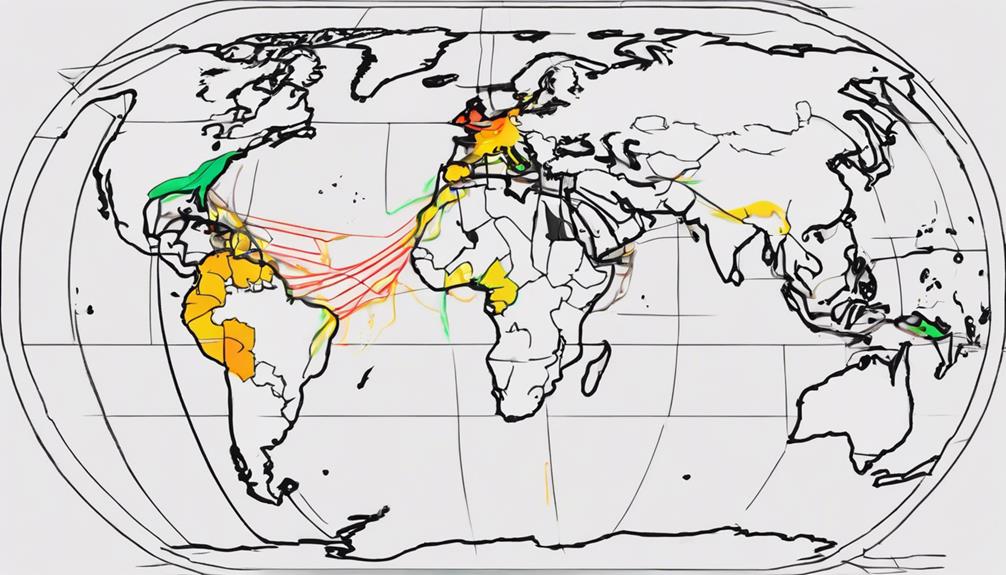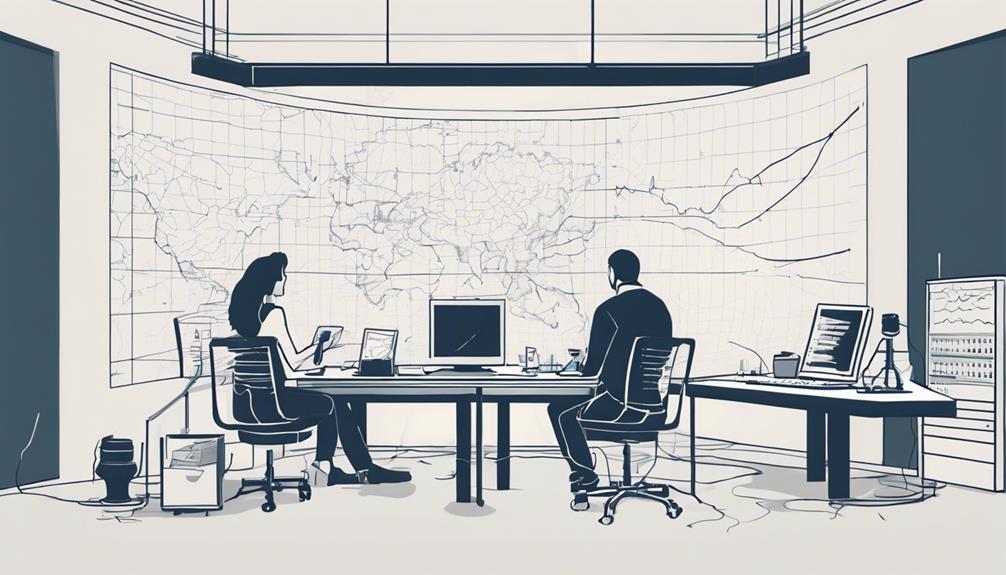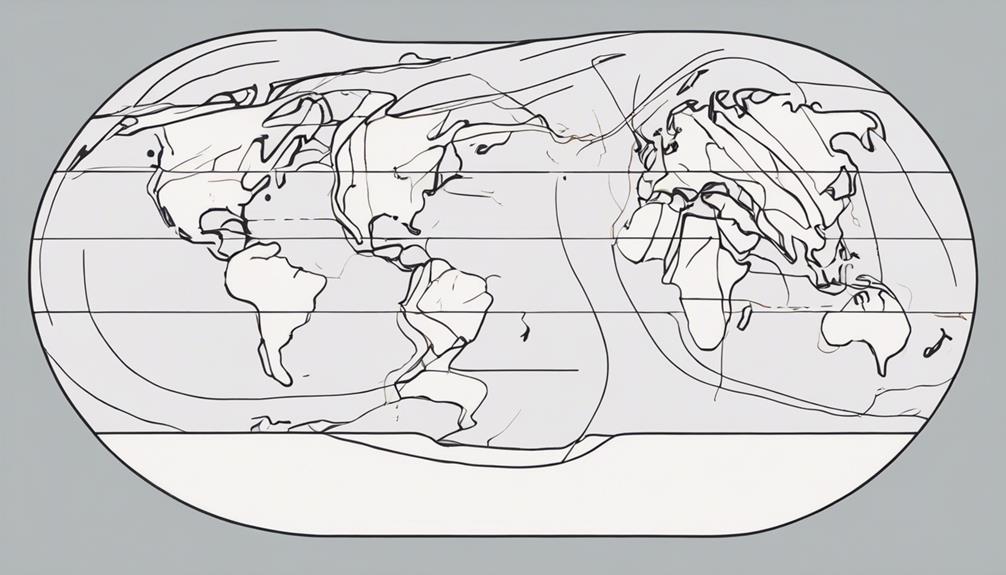Earthquakes, a natural phenomenon that can have devastating consequences, are not randomly distributed across the globe. The underlying geological processes play a crucial role in determining the frequency and intensity of seismic events in specific regions. Factors such as tectonic plate interactions, fault lines, and volcanic activity contribute to the elevated seismicity in certain areas. By exploring the geophysical characteristics of these earthquake-prone zones, we can gain valuable insights into the mechanisms driving these events and, more importantly, develop strategies to mitigate risks and enhance our resilience to future seismic hazards.
Key Takeaways
- Plate boundaries and fault lines influence seismic activity distribution.
- Divergent, convergent, and transform boundaries contribute differently to earthquake occurrence.
- Subduction zones and fault line interactions increase earthquake risks significantly.
- Understanding geological factors like stress, subduction zones, and fault lines is crucial in earthquake assessment.
Earthquake Causes and Factors

The occurrence and frequency of earthquakes are intricately linked to various geological factors, such as proximity to tectonic plate boundaries and the presence of geological fault lines. Tectonic plates, the massive slabs of the Earth's lithosphere, interact along their boundaries, leading to seismic activity. Regions situated near plate boundaries often experience more earthquakes due to the intense tectonic forces at work. The movement of these plates can create stress within the Earth's crust, eventually causing it to rupture and produce earthquakes.
Plate boundaries, where these tectonic plates meet, are hotspots for seismic events. Subduction zones, where one plate dives beneath another, are particularly prone to earthquakes as the descending plate generates intense pressure and friction. Along with plate boundaries, geological fault lines play a crucial role in earthquake occurrence. Fault lines are fractures in the Earth's crust where blocks of rock have moved relative to each other, releasing accumulated stress in the form of seismic waves. Understanding the relationship between tectonic plates, plate boundaries, and fault lines is essential in comprehending why certain areas experience more earthquakes than others.
Tectonic Plate Boundaries Influence
Tectonic interactions at plate boundaries exert a significant influence on seismic activity levels. Different types of plate boundaries contribute to varying levels of seismicity. Below is a table illustrating how different plate boundaries influence seismic activity:
| Plate Boundary | Seismic Activity | Influence |
|---|---|---|
| Divergent | Moderate seismic activity due to plates moving apart | Creates seismic activity |
| Convergent | High seismic activity as plates collide | Leads to powerful earthquakes |
| Transform | Frequent earthquakes as plates slide past each other | Triggers frequent seismic events |
One of the most noteworthy plate boundary settings is subduction zones. These areas, where one tectonic plate plunges beneath another, are particularly prone to intense seismic events. Subduction zones often give rise to some of the most powerful earthquakes recorded. Understanding the dynamics of plate boundaries is crucial in comprehending the distribution and intensity of earthquakes worldwide.
Subduction Zones and Earthquakes

Plate boundaries, particularly subduction zones, play a critical role in shaping seismic activity levels around the world. Subduction zones are regions where one tectonic plate is being forced beneath another into the Earth's mantle. This process creates immense pressure and friction, which can result in powerful earthquakes. The Pacific Ring of Fire is a well-known area characterized by intense volcanic activity and frequent earthquakes, primarily due to the presence of multiple subduction zones. For instance, the subduction zone off the coast of Japan has historically generated devastating earthquakes and tsunamis, highlighting the dangers associated with such geological features. Similarly, the Cascadia Subduction Zone along the west coast of North America is a major concern for earthquake experts due to its potential to unleash a high-magnitude earthquake followed by a tsunami. Understanding the dynamics of subduction zones is crucial for assessing earthquake risks in highly vulnerable regions worldwide and implementing effective mitigation strategies.
Fault Lines and Seismic Activity
What factors contribute to the heightened seismic activity along fault lines worldwide? Fault lines are zones where tectonic plates interact, leading to significant geological events such as earthquakes. The movement of these plates along fault lines can result in intense seismic activity due to the build-up and release of stress. For instance, the San Andreas Fault in California is notorious for its frequent earthquakes caused by the Pacific and North American plates sliding past each other. Similarly, regions near subduction zones, like the Pacific Ring of Fire, experience intense seismic events as one tectonic plate subducts beneath another, triggering earthquakes. Active faults, such as the Himalayan belt, serve as focal points for seismic activity, making these areas prone to earthquakes. The interaction of tectonic plates along fault lines, like the Mid-Atlantic Ridge, generates substantial seismic events. Geological instability in regions like the Eastern Mediterranean contributes to the occurrence of frequent earthquakes due to ongoing tectonic movements. Understanding the dynamics of fault lines and tectonic plates is crucial in predicting and mitigating earthquake hazards.
Location and Earthquake Frequency

Regions situated near geographic fault lines and tectonic plate boundaries exhibit a higher frequency of earthquakes due to the dynamic movements and interactions of these massive geological structures. The constant shifts and collisions between tectonic plates create immense pressure and stress, which can trigger seismic events with varying magnitudes. Understanding the correlation between location and earthquake frequency is crucial for assessing seismic hazards and implementing effective mitigation strategies in vulnerable areas.
Geographic Fault Lines
Why do certain geographic fault lines correlate with increased earthquake frequency? Regions situated along tectonic plate boundaries, like the San Andreas Fault, are more prone to earthquakes due to the dynamic interactions between these massive plates. The Pacific Ring of Fire, characterized by multiple plate collisions, experiences frequent seismic activity. Additionally, areas near subduction zones, such as Japan and Indonesia, face a high risk of powerful earthquakes. Fault lines, like the San Andreas Fault in California, create localized earthquake hotspots. Geological features such as the mid-Atlantic Ridge also contribute to heightened earthquake occurrence in specific regions, emphasizing the critical role of geographic fault lines in determining earthquake frequency.
Tectonic Plate Movements
Situated at the junctures of tectonic plates, regions near plate boundaries exhibit heightened seismic activity due to the dynamic interactions and movements occurring between these massive geological structures. Earthquakes occur along these boundaries as a result of the forces that cause the plates to move. The Pacific Ring of Fire, for instance, is a prime example of a region where earthquakes are prevalent due to the collision and subduction of multiple tectonic plates. Subduction zones, like the Cascadia Subduction Zone, are known for generating powerful earthquakes as one plate descends beneath another. While intraplate earthquakes can also occur within tectonic plates, the majority of seismic events are concentrated at plate boundaries where the stress from plate movements is most pronounced. This direct correlation underscores the significance of tectonic plate movements in influencing earthquake frequency worldwide.
Seismicity in Volcanic Regions
In volcanic regions, the interaction of magma with the surrounding rock and groundwater can trigger seismic events. The movement of magma beneath the surface exerts pressure on the Earth's crust, leading to earthquakes. High seismicity in volcanic areas like the Pacific Ring of Fire is a result of the active volcanic systems present in these regions.
Volcanoes and Seismic Activity
Volcanic regions exhibit heightened seismic activity attributed to the dynamic movement of magma and volcanic processes. This increased seismicity is primarily due to the following factors:
- Subduction Zones: Common in volcanic regions, these zones involve one tectonic plate being forced beneath another, leading to intense seismic activity.
- Magma Movement: Pressure and stress from magma beneath the Earth's surface can trigger volcanic earthquakes.
- Ring of Fire: This belt of volcanoes around the Pacific Ocean experiences frequent earthquakes, showcasing the relationship between volcanoes and seismic events.
- Monitoring Importance: Tracking seismic activity in volcanic regions is vital for eruption prediction and understanding the interplay between volcanoes and earthquakes.
- Risk Assessment: Assessing seismic activity in these regions aids in evaluating the potential hazards posed by volcanic eruptions.
Tectonic Plates and Earthquakes
Regions with heightened seismic activity in volcanic areas often stem from the intricate interactions between tectonic plates beneath Earth's surface. The movement and collision of these plates at various types of plate boundaries lead to increased earthquake occurrences. Here is a table highlighting the relationship between tectonic plates, earthquakes, and plate boundaries:
| Tectonic Plates | Earthquakes | Plate Boundaries |
|---|---|---|
| Interaction and movement of massive slabs of rock beneath the Earth's surface | Result in seismic events due to the release of built-up stress and pressure | Convergent, divergent, and transform boundaries contribute to seismic activity |
| Subduction zones where one plate descends beneath another | Common sites for significant earthquake occurrences | Areas where tectonic plates converge, diverge, or slide past each other |
| Molten rock movement in volcanic regions releasing pressure | Increases seismicity and earthquake frequency | Locations where plates interact and generate seismic activity |
Earthquake Prediction Challenges

Understanding the complexities of seismic activities poses formidable challenges in the realm of earthquake prediction. The following factors contribute to the difficulties in accurately forecasting earthquakes:
- Seismic Activities: The intricate processes occurring beneath the Earth's surface involve various interactions between tectonic plates, making it challenging to pinpoint exact locations and timings of earthquakes.
- Fault Mapping: Mapping faults provides insights into potential earthquake-prone areas, but the complexities of fault systems and their behaviors add layers of uncertainty to prediction efforts.
- Historical Data: While historical data offer valuable information about past seismic events, translating this data into precise forecasts remains a challenge due to the dynamic nature of fault movements.
- Monitoring Techniques: Continuous monitoring of seismic activities helps in assessing risks, but the vast amount of data and interpreting meaningful patterns pose significant challenges.
- Forecasting Methods: The lack of precise forecasting methods stems from the multifaceted nature of seismic events and the inability to predict the exact magnitude and timing of earthquakes accurately.
Human Activities and Quakes
Human-induced seismic events, spurred by various human activities, are a significant concern due to their potential to trigger earthquakes in regions where they may not naturally occur. Activities such as mining and reservoir-induced seismicity have been identified as potential triggers for earthquakes. Mining, by destabilizing the ground, can induce seismic events in areas that are not typically prone to earthquakes. Reservoir-induced seismicity occurs when water reservoirs create pressure on faults, leading to earthquakes. Additionally, deep well injection, fracking, and geothermal energy extraction have also been linked to induced earthquakes. The processes involved in these activities can alter subsurface pressure and stress, potentially causing seismic events. As human-induced earthquakes emerge as a growing concern, it is crucial to implement careful monitoring and regulation practices to mitigate associated risks. Understanding the correlation between human activities and induced earthquakes is essential for developing strategies to minimize their impact on seismicity in various regions.
Geological Features Impacting Earthquakes

The geological features of a region play a pivotal role in influencing the occurrence and intensity of earthquakes, with factors such as tectonic plate movements and fault lines creating zones of vulnerability to seismic activity. Tectonic plates form the outer shell of the Earth and interact along their boundaries, leading to seismic events when they move or collide. Fault lines are fractures in the Earth's crust where rocks on either side have moved relative to each other, causing instability and potential earthquakes. Subduction zones, where one tectonic plate slides beneath another, are prone to intense seismic activity due to the immense pressure and friction involved. The presence of magma chambers near fault lines can trigger frequent and powerful earthquakes as the movement of molten rock affects the surrounding crust. Stress accumulation over time in areas with fast plate movements results in more frequent and significant earthquakes, highlighting the dynamic nature of seismic activity influenced by geological features.
Seismic Hazard Mapping Importance
Effective seismic hazard mapping is essential for identifying and mitigating earthquake risks in vulnerable regions. By analyzing geological data, fault lines, and tectonic plate boundaries, scientists can predict the likelihood of earthquakes in specific areas. These maps are crucial for prioritizing resources and developing earthquake preparedness strategies. Understanding seismic hazard mapping helps governments and organizations allocate funds for infrastructure development and emergency response planning in high-risk zones. By utilizing these maps, urban planners can make informed decisions to enhance public safety and reduce the impact of potential earthquake disasters. The integration of seismic hazard mapping into risk assessment processes is fundamental for improving resilience and overall earthquake preparedness. Overall, seismic hazard mapping plays a critical role in helping societies adapt to the threats posed by earthquakes and ensuring proactive measures are in place to mitigate risks effectively.
Mitigating Risks in High-Risk Areas

Strategically implementing mitigation measures is paramount in high-risk earthquake areas to enhance resilience and minimize potential devastation. To achieve this, several key strategies can be employed:
- Building Codes and Regulations: Ensuring that structures are constructed to withstand seismic activity helps reduce the risk of collapse during earthquakes.
- Early Warning Systems: Implementing systems that provide advance notice of seismic events can save lives by enabling timely evacuations.
- Emergency Response Training: Preparing communities through training and drills ensures effective responses to earthquakes, minimizing casualties.
- Retrofitting Vulnerable Structures: Strengthening buildings through retrofitting with seismic reinforcement techniques can significantly decrease the impact of earthquakes.
- Public Awareness Campaigns: Educating residents about risks, safety measures, and evacuation procedures enhances preparedness and resilience in earthquake-prone areas.
Frequently Asked Questions
Why Are There More Earthquakes in Certain Places?
Earthquakes occur more frequently in certain regions due to the distribution of fault lines along tectonic plate boundaries. The movement of these plates creates intense seismic activity, leading to increased occurrences of earthquakes. Areas with active fault systems, subduction zones, and volcanic activity are especially prone to frequent earthquakes. The interaction between tectonic plates generates immense pressure, resulting in the release of seismic energy, contributing to the higher seismicity in these specific locations.
Why Do Some States Have More Earthquakes Than Others?
Seismic activity patterns vary among states due to the interaction of geographic fault lines and tectonic plate movements. Factors such as proximity to plate boundaries, fault complexity, and human-induced activities influence earthquake frequency. Alaska's location on the Pacific Ring of Fire exposes it to high seismicity, while California's numerous fault lines contribute to its earthquake risk. Understanding these geological dynamics helps explain why some states experience more earthquakes than others.
What Causes More Earthquakes?
Fault lines, tectonic plates, and seismic activity are primary factors contributing to increased earthquake occurrences. Geological factors such as subduction zones and magma chambers play crucial roles. Stress accumulation over time also leads to more frequent and intense seismic events. Human activities can exacerbate these natural processes. Understanding the interplay of these elements is essential for predicting and mitigating earthquake risks in vulnerable regions.
Where Do 95% of Earthquakes Happen and Why?
The overwhelming majority, 95%, of earthquakes occur along the boundaries of tectonic plates, where intense interactions lead to frequent seismic activity. The Pacific Ring of Fire and other active fault zones are primary locations for these events. Subduction zones, where one plate descends beneath another, are particularly prone to powerful earthquakes due to the release of accumulated stress along faults. This frequency distribution is closely tied to the dynamics of plate tectonics and seismic activity.
Conclusion
In conclusion, the frequency of earthquakes in certain regions is dictated by a multitude of geological factors such as tectonic plate boundaries, subduction zones, fault lines, and human activities. These areas experience heightened seismic activity due to the complex interplay of these factors. Understanding these geological features is crucial for effective earthquake preparedness, mitigation strategies, and risk reduction in vulnerable regions. Earthquake-prone areas require continuous monitoring and proactive measures to minimize the impact of seismic events.
